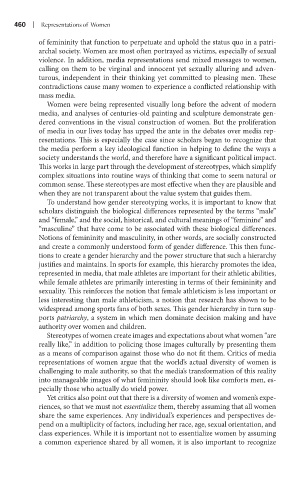Page 481 - Battleground The Media Volume 1 and 2
P. 481
0 | Representat ons of Women
of femininity that function to perpetuate and uphold the status quo in a patri-
archal society. Women are most often portrayed as victims, especially of sexual
violence. In addition, media representations send mixed messages to women,
calling on them to be virginal and innocent yet sexually alluring and adven-
turous, independent in their thinking yet committed to pleasing men. These
contradictions cause many women to experience a conflicted relationship with
mass media.
Women were being represented visually long before the advent of modern
media, and analyses of centuries-old painting and sculpture demonstrate gen-
dered conventions in the visual construction of women. But the proliferation
of media in our lives today has upped the ante in the debates over media rep-
resentations. This is especially the case since scholars began to recognize that
the media perform a key ideological function in helping to define the ways a
society understands the world, and therefore have a significant political impact.
This works in large part through the development of stereotypes, which simplify
complex situations into routine ways of thinking that come to seem natural or
common sense. These stereotypes are most effective when they are plausible and
when they are not transparent about the value system that guides them.
To understand how gender stereotyping works, it is important to know that
scholars distinguish the biological differences represented by the terms “male”
and “female,” and the social, historical, and cultural meanings of “feminine” and
“masculine” that have come to be associated with these biological differences.
Notions of femininity and masculinity, in other words, are socially constructed
and create a commonly understood form of gender difference. This then func-
tions to create a gender hierarchy and the power structure that such a hierarchy
justifies and maintains. In sports for example, this hierarchy promotes the idea,
represented in media, that male athletes are important for their athletic abilities,
while female athletes are primarily interesting in terms of their femininity and
sexuality. This reinforces the notion that female athleticism is less important or
less interesting than male athleticism, a notion that research has shown to be
widespread among sports fans of both sexes. This gender hierarchy in turn sup-
ports patriarchy, a system in which men dominate decision making and have
authority over women and children.
Stereotypes of women create images and expectations about what women “are
really like,” in addition to policing those images culturally by presenting them
as a means of comparison against those who do not fit them. Critics of media
representations of women argue that the world’s actual diversity of women is
challenging to male authority, so that the media’s transformation of this reality
into manageable images of what femininity should look like comforts men, es-
pecially those who actually do wield power.
Yet critics also point out that there is a diversity of women and women’s expe-
riences, so that we must not essentialize them, thereby assuming that all women
share the same experiences. Any individual’s experiences and perspectives de-
pend on a multiplicity of factors, including her race, age, sexual orientation, and
class experiences. While it is important not to essentialize women by assuming
a common experience shared by all women, it is also important to recognize

